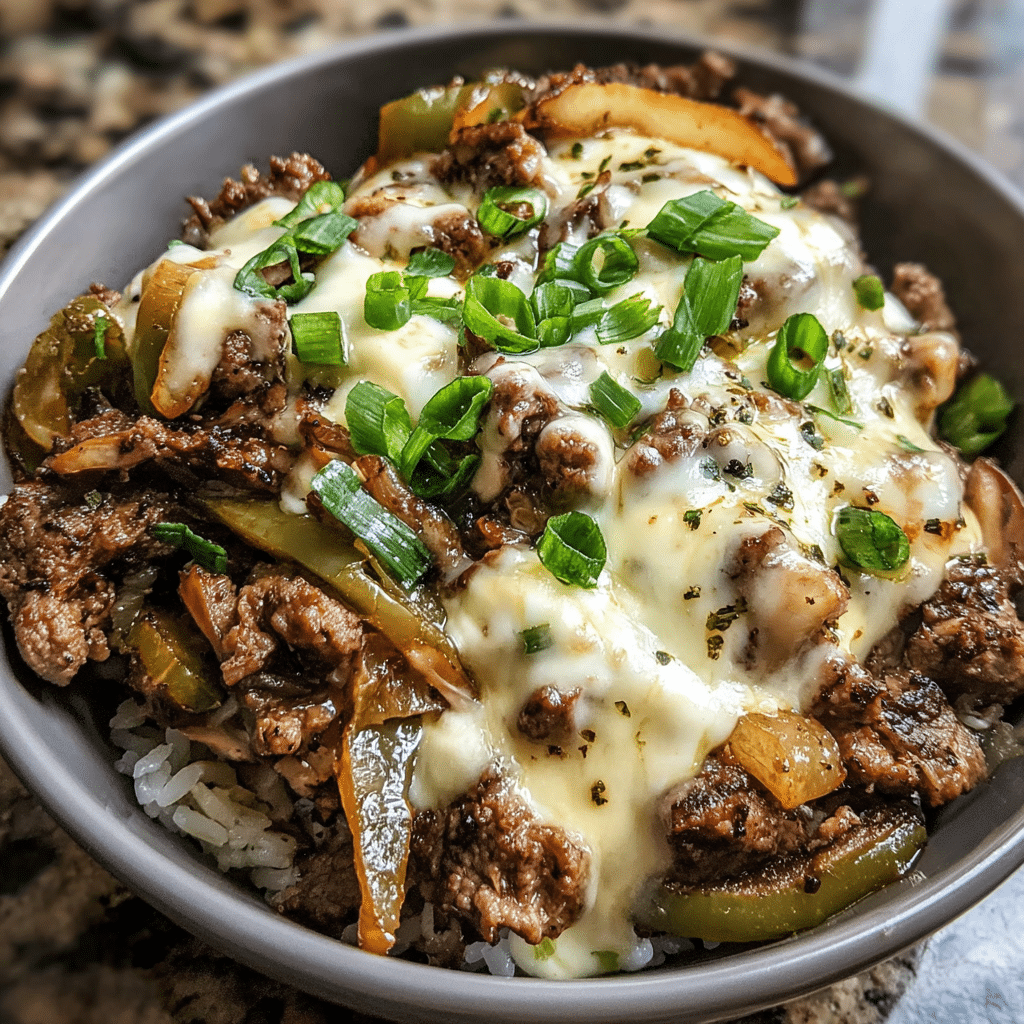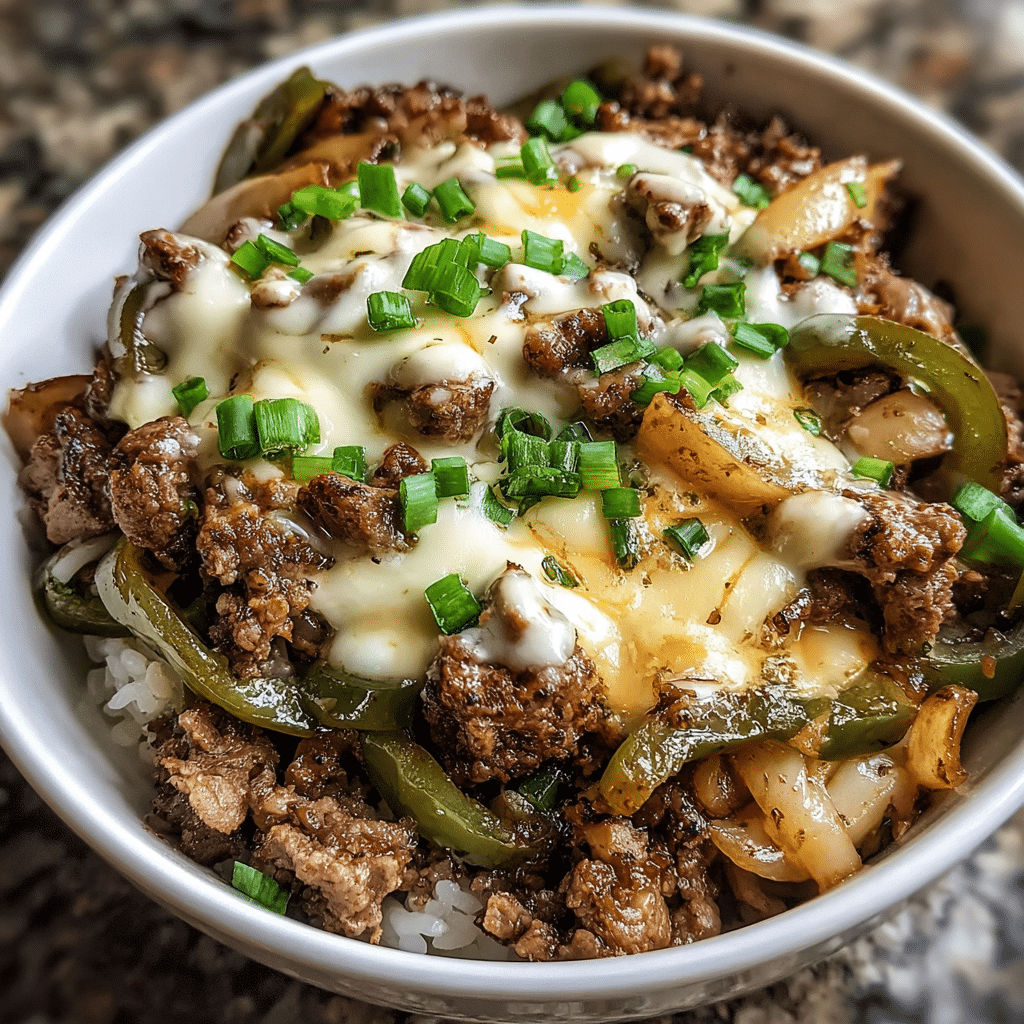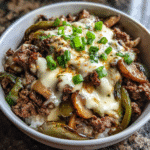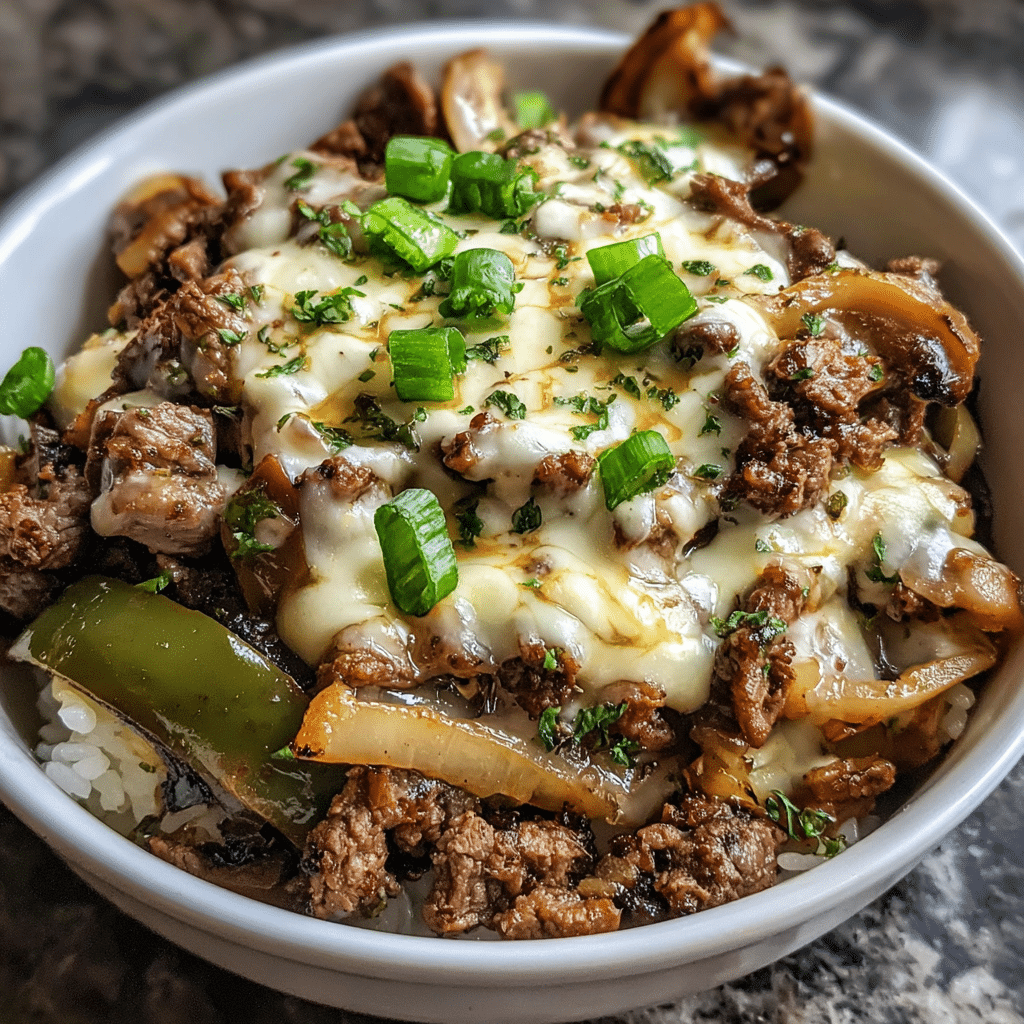Philly Cheesesteak Bowls have revolutionized the way we think about this iconic sandwich, transforming it into a versatile, meal-prep friendly dish that captures every beloved flavor without the mess. As someone who’s spent years reimagining traditional dishes and creating bold new flavors that excite the senses, I knew I had to tackle the challenge of deconstructing Philadelphia’s most famous export into something even more satisfying.
My journey with this recipe began during a particularly busy week when I was craving that perfect combination of tender steak, caramelized onions, and melted cheese, but needed something more substantial and easier to customize for my family’s diverse dietary needs. That’s when inspiration struck why not take all those incredible flavors and present them in a bowl format that’s not only more practical but also infinitely more adaptable?
With my background in culinary arts and passion for making every dish a feast for both the eyes and taste buds, I’ve perfected this Philly Cheesesteak Bowl recipe that delivers restaurant-quality results in your own kitchen. This isn’t just another deconstructed sandwich it’s a complete reimagining that offers better portion control, easier customization, and the ability to make it gluten-free, low-carb, or adapted to virtually any dietary preference.
In this comprehensive guide, I’ll share everything you need to know about selecting the perfect cuts of meat, mastering the cooking techniques that ensure tender, flavorful results every time, and exploring countless variations that will keep this recipe exciting for years to come.
Why This Philly Cheesesteak Bowl Recipe Works
The genius of Philly Cheesesteak Bowls lies in their perfect balance of flavor, convenience, and versatility. Unlike traditional cheesesteaks that can be messy and difficult to customize, these bowls offer a controlled, elegant presentation that doesn’t sacrifice any of the authentic taste experience.
This recipe works because it uses affordable, easy-to-find cuts of meat that deliver maximum flavor without breaking the budget. The beauty of ribeye or sirloin is that these cuts have the perfect marbling and texture to create that signature cheesesteak experience, but when sliced thin and cooked properly, even more budget-friendly options can shine.
The marinade process requires just 15 minutes for maximum tenderness, making this perfect for weeknight dinners when time is precious but you refuse to compromise on flavor. The combination of proper seasoning and quick, high-heat cooking ensures that every bite delivers that perfect contrast between caramelized edges and juicy centers.
Most importantly, these bowls are perfect for both weeknight convenience and weekend entertaining. They’re naturally scalable, making them ideal for meal prep enthusiasts who want to enjoy restaurant-quality meals throughout the week, while also being impressive enough to serve at dinner parties where guests can customize their own bowls with various toppings and sides.
Choosing the Right Meat for Philly Cheesesteak Bowls
The foundation of exceptional Philly Cheesesteak Bowls starts with selecting the right cut of meat, and this decision can make or break your final dish.
Best Cuts for This Philly Cheesesteak Bowl Recipe
Ribeye remains the gold standard for authentic Philly cheesesteaks, and for good reason. The generous marbling throughout the meat ensures that each slice stays incredibly tender and flavorful, even with the quick cooking method required for this dish. The fat content in ribeye also helps create those beautifully caramelized edges that give the meat its signature texture and depth of flavor.
Sirloin offers an excellent alternative that balances flavor with affordability. While leaner than ribeye, sirloin still provides enough tenderness when sliced properly and cooked at the right temperature. The key is to not overcook it, as the lower fat content means it can become tough more quickly than fattier cuts.
For those looking for premium options, strip steak works beautifully in this preparation, offering excellent flavor and tenderness. Flank steak can also work well if sliced against the grain and not overcooked, though it requires more attention to achieve optimal results.
Buying Tips for Perfect Philly Cheesesteak Bowls
When shopping for meat, look for bright red color without any brown or gray spots, which indicates freshness. The meat should feel firm to the touch and have minimal odor fresh meat should smell clean and slightly metallic, never sour or ammonia-like.
Don’t hesitate to ask your butcher for specific cuts or even to slice the meat for you. Many butchers will gladly slice ribeye or sirloin to your preferred thickness, which saves time and ensures consistent results. Ask for slices about ⅛ inch thick thin enough to cook quickly but thick enough to maintain texture.
If you’re buying pre-packaged meat, check the marbling pattern. Good ribeye should have white streaks of fat distributed throughout the red meat. For sirloin, look for even color and minimal connective tissue.
Substitutions for Philly Cheesesteak Bowls
While traditional cuts work best, there are several substitutions that can accommodate different budgets and dietary needs. Chicken thighs can be substituted for a poultry version, offering similar richness and staying power as beef. Pork shoulder, when sliced thin, provides excellent flavor and tenderness at a lower price point.
For those following specific diets, turkey breast can work for a leaner option, though it requires careful cooking to prevent drying out. Even plant-based alternatives like seasoned mushrooms or seitan can capture the essence of the dish while meeting vegan requirements.
Ingredients & Prep for Perfect Philly Cheesesteak Bowls
Success with Philly Cheesesteak Bowls begins long before the cooking starts, and proper preparation is what separates good results from extraordinary ones.
Complete Ingredients List for Philly Cheesesteak Bowls (4 Servings)
For the Meat:
- 1 lb (450 g) thinly sliced steak (ribeye or sirloin works best)
- 1 tsp salt
- ½ tsp black pepper
- ½ tsp smoked paprika (optional)
For the Vegetables:
- 1 tbsp olive oil (plus extra if needed)
- 1 large onion, thinly sliced
- 2 bell peppers (any color), thinly sliced
- 2 cloves garlic, minced
For Assembly:
- 1 cup shredded provolone or mozzarella cheese
- 4 cups cooked rice or cauliflower rice (for a low-carb option)
Optional Toppings:
- Fresh parsley, chopped
- Hot sauce
- Sautéed mushrooms
- Extra cheese for garnish
Meat Prep Essentials for Philly Cheesesteak Bowls
The secret to tender, flavorful meat starts with proper preparation. Begin by patting the meat completely dry with paper towels this crucial step ensures proper searing and prevents steaming. Any surface moisture will create steam in the pan, preventing the beautiful caramelization that gives the meat its signature flavor and texture.
If your meat isn’t pre-sliced, place it in the freezer for 15-20 minutes before cutting. This firms up the meat just enough to make slicing easier and more consistent. Use a sharp knife to cut against the grain in thin, even slices. Cutting against the grain breaks down the muscle fibers, resulting in more tender bites.
For optimal results, allow the sliced meat to come to room temperature for 15-20 minutes before cooking. Cold meat hitting a hot pan can cause uneven cooking and tougher results.
Marinades and Seasonings for Philly Cheesesteak Bowls
While traditional Philly cheesesteaks rely primarily on salt and pepper, these bowls benefit from a slightly more complex seasoning approach. The basic seasoning of salt, black pepper, and optional smoked paprika creates a perfect foundation that enhances the meat’s natural flavors without overwhelming them.
The smoked paprika is particularly brilliant here it adds a subtle depth and smokiness that mimics the flavor development you’d get from a traditional grill or flat-top, even when cooking in a home skillet. This small addition elevates the entire dish from good to restaurant-quality.
For those who want to marinate the meat, a simple mixture of olive oil, garlic, salt, and pepper for 15-30 minutes will enhance tenderness and flavor. Longer marinating isn’t necessary and can actually break down the meat’s texture too much.
Pantry Staples for Philly Cheesesteak Bowls
The supporting ingredients are what make these bowls truly special. High-quality olive oil is essential it needs to withstand high heat without smoking while adding its own subtle flavor to the vegetables and meat.
Fresh garlic is non-negotiable; pre-minced garlic from a jar simply doesn’t provide the bright, pungent flavor that fresh garlic delivers. The difference is particularly noticeable in a dish this simple, where every ingredient’s quality matters.
Your choice of cheese can dramatically impact the final result. Provolone offers the most authentic Philly cheesesteak experience with its mild, creamy flavor and excellent melting properties. Mozzarella provides a slightly different but equally delicious experience with more stretch and a milder flavor profile.

Step-by-Step Cooking Instructions for Philly Cheesesteak Bowls
Mastering the cooking technique is crucial for achieving that perfect balance of tender meat, caramelized vegetables, and melted cheese that defines exceptional Philly Cheesesteak Bowls.
Pre-Cooking Prep for Philly Cheesesteak Bowls
Before any heat touches the pan, ensure all your ingredients are properly prepared and within arm’s reach. This dish cooks quickly, so having everything ready prevents overcooking while you scramble for ingredients.
Pat the meat dry one final time and season it just before cooking seasoning too early can draw out moisture. Have your sliced onions and peppers ready in separate bowls, as they’ll be added at different times for optimal texture.
Preheat your skillet over medium-high heat for 2-3 minutes before adding oil. A properly heated pan ensures immediate searing and prevents sticking.
Cooking Method for Perfect Philly Cheesesteak Bowls
The cooking process follows a carefully orchestrated sequence that builds flavor at each step. Start with the vegetables, as they take longer to develop proper caramelization. Cook the onions and peppers until they’re softened and slightly caramelized, which typically takes 6-8 minutes. This caramelization process develops natural sugars and creates depth of flavor that raw or undercooked vegetables simply can’t provide.
Add the minced garlic during the final minute of vegetable cooking. Garlic burns easily, so this timing ensures it becomes fragrant and develops flavor without becoming bitter.
Remove the vegetables and immediately begin cooking the meat in the same pan. This allows the meat to pick up any remaining flavors from the vegetables while developing its own caramelization. Cook the meat in batches if necessary overcrowding leads to steaming rather than searing.
Doneness Check for Philly Cheesesteak Bowls
For beef, aim for an internal temperature of 130-135°F for medium-rare, or 135-145°F for medium. The thin slicing means the meat cooks extremely quickly, usually within 2-3 minutes total. Visual cues are equally important look for a nice brown sear on the outside while maintaining a pink center for beef.
The meat should feel slightly firm but still give when pressed gently with tongs. Overcooked meat becomes tough and chewy, which completely undermines the dish’s appeal.
Resting and Assembly for Philly Cheesesteak Bowls
Once the meat reaches proper doneness, immediately return the vegetables to the pan and toss everything together. This brief reheating marries the flavors while warming the vegetables back to serving temperature.
Add the cheese directly to the hot meat and vegetable mixture, then cover the pan briefly to encourage melting. This technique creates that perfect cheese pull that makes the dish so visually appealing and delicious.
Pro Tips for Perfect Philly Cheesesteak Bowls
Avoiding Tough, Dry Meat in Philly Cheesesteak Bowls
The most common mistake when making these bowls is overcooking the meat. Remember that thin slices of quality beef cook extremely quickly, and carryover cooking will continue even after removing from heat. Pull the meat just before it reaches your target doneness.
Never overcrowd the pan this drops the temperature and causes steaming instead of searing. If cooking for a large group, work in batches and keep cooked meat warm in a low oven.
Basting with butter during the final moments of cooking adds richness and helps prevent the exterior from becoming too dry while the interior finishes cooking.
Tool Recommendations for Philly Cheesesteak Bowls
A reliable meat thermometer takes the guesswork out of achieving perfect doneness, especially when you’re still learning the visual and tactile cues. Digital instant-read thermometers provide quick, accurate readings that prevent overcooking.
A well-seasoned cast-iron skillet or heavy-bottomed stainless steel pan provides even heat distribution and excellent searing capabilities. Non-stick pans can work but won’t develop the same level of caramelization.
Sharp knives are essential for clean, even slicing. A dull knife will tear the meat fibers, leading to uneven cooking and compromised texture.
Storage & Reheating Philly Cheesesteak Bowls
Store leftovers in airtight containers in the refrigerator for up to 3 days. The key to maintaining quality is proper cooling allow the mixture to cool completely before refrigerating to prevent condensation that can make the meat soggy.
For reheating, use a skillet over medium heat rather than the microwave. Add a splash of beef broth or water to prevent sticking and help redistribute moisture. The goal is to warm through gently without further cooking the meat.
These bowls also freeze well for up to 3 months when stored in freezer-safe containers with minimal air exposure. Thaw overnight in the refrigerator before reheating.
Flavor Variations for Philly Cheesesteak Bowls
Spicy Twist on Philly Cheesesteak Bowls
Transform your bowls with heat by incorporating chipotle peppers in adobo sauce, adding both smokiness and spice. Start with one minced chipotle pepper and adjust to taste – the adobo sauce provides additional flavor complexity beyond just heat.
Cayenne pepper offers clean heat without additional flavors, while jalapeños provide fresh heat and crunch when added with the bell peppers. Hot sauce can be added individually, allowing diners to customize their heat level.
Keto and Paleo Philly Cheesesteak Bowls
For keto followers, substitute cauliflower rice for regular rice and ensure your seasonings don’t contain hidden sugars. The natural fats in the meat and cheese align perfectly with ketogenic macronutrient requirements.
Paleo adaptations require eliminating the cheese and focusing on the natural flavors of the meat and vegetables. Nutritional yeast can provide some of that umami depth that cheese typically contributes, while avocado adds richness and healthy fats.
Global Flavors for Philly Cheesesteak Bowls
Korean-inspired versions using gochujang marinade create an exciting fusion that maintains the dish’s comfort food appeal while introducing complex fermented flavors. The sweetness and heat of gochujang complement the beef beautifully.
Italian herb crusts using fresh rosemary, thyme, and oregano create a Mediterranean twist that pairs excellently with mozzarella cheese. Mexican variations with cumin, chili powder, and lime juice offer bright, bold flavors that work particularly well with pepper jack cheese.
| Variation | Key Ingredients | Cheese Pairing | Best Base |
|---|---|---|---|
| Classic Philly | Salt, pepper, paprika | Provolone | White rice |
| Spicy Chipotle | Chipotle peppers, adobo sauce | Pepper jack | Cilantro lime rice |
| Korean Fusion | Gochujang, sesame oil, garlic | Mozzarella | Brown rice |
| Italian Herb | Rosemary, thyme, oregano | Fresh mozzarella | Cauliflower rice |
| Mexican Style | Cumin, chili powder, lime | Queso fresco | Spanish rice |
Serving Suggestions for Philly Cheesesteak Bowls
The beauty of these bowls lies in their adaptability to various dining occasions and dietary preferences. For casual weeknight dinners, serve over fluffy white rice with a simple side salad dressed in vinaigrette to cut through the richness.
For more elegant presentations, consider serving over wild rice pilaf or herb-infused quinoa, which adds textural interest and nutritional value. Creamy mashed potatoes create an indulgent base that transforms the dish into pure comfort food, while grilled asparagus or roasted Brussels sprouts provide fresh, crisp contrasts to the rich meat and cheese.
Wine pairings enhance the dining experience significantly. A bold Cabernet Sauvignon complements the beef’s richness, while its tannins cut through the cheese’s creaminess. For white wine lovers, a full-bodied Chardonnay provides enough weight to stand up to the dish’s robust flavors.
Beer pairings offer more casual options a crisp lager cleanses the palate between bites, while a hoppy IPA’s bitterness provides excellent contrast to the cheese and caramelized onions.

FAQs About Philly Cheesesteak Bowls
Can I use frozen meat for Philly Cheesesteak Bowls?
While fresh meat provides the best results, frozen meat can work if properly thawed and prepared. Thaw completely in the refrigerator overnight, then pat thoroughly dry before slicing and cooking. Frozen meat often releases more moisture during cooking, so be prepared for longer cooking times to achieve proper caramelization.
How do I fix overcooked meat in Philly Cheesesteak Bowls?
Unfortunately, overcooked meat can’t be undone, but you can minimize the damage by adding moisture back to the dish. Incorporate a splash of beef broth, Worcestershire sauce, or even butter to help rehydrate the meat. Serving over a saucy base or adding extra cheese can also help mask texture issues.
Is this Philly Cheesesteak Bowl recipe safe for pregnant women?
When prepared properly with meat cooked to safe internal temperatures (145°F for beef), this recipe is safe for pregnant women. Ensure all vegetables are thoroughly cooked and practice proper food safety during preparation and storage. Pregnant women should avoid undercooked meat, so aim for medium doneness rather than medium-rare.
Can I make Philly Cheesesteak Bowls ahead of time?
The components can be prepped ahead, but final assembly should happen just before serving for best results. Cook the meat and vegetables, then store separately in the refrigerator. Reheat gently in a skillet when ready to serve, adding cheese at the last moment.
What’s the best way to slice meat for Philly Cheesesteak Bowls?
Slice against the grain in thin, even pieces about ⅛ inch thick. Partially freezing the meat for 15-20 minutes makes slicing easier and more consistent. A sharp knife is crucial dull knives tear the meat fibers and create uneven cooking.
Can I use different cheeses in Philly Cheesesteak Bowls?
Absolutely! While provolone is traditional, mozzarella, American cheese, or even sharp cheddar work well. Choose cheeses that melt smoothly and complement the beef’s flavor. Avoid hard cheeses that don’t melt well, as they won’t create the desired creamy texture.
Conclusion
These Philly Cheesesteak Bowls represent everything I love about reimagining classic dishes they maintain all the beloved flavors we crave while offering improved convenience, customization, and presentation. Through careful attention to meat selection, proper cooking techniques, and thoughtful seasoning, you can create restaurant-quality results that surpass the original in both flavor and practicality.
The versatility of this recipe means it can easily become a regular part of your meal rotation, adapting to seasonal ingredients, dietary changes, and varying occasions. Whether you’re meal prepping for a busy week, entertaining friends, or simply treating your family to something special, these bowls deliver satisfaction every time.
Fire up your skillet and try this recipe tonight I guarantee it will become a new favorite that you’ll find yourself craving again and again. The combination of tender, perfectly seasoned meat, caramelized vegetables, and melted cheese over your choice of base creates a dining experience that’s both comforting and exciting.
Join the thousands of home cooks who’ve already discovered the magic of Philly Cheesesteak Bowls, and don’t forget to share your own variations and experiences. The FoodyDish.com community thrives on creativity and connection through food, and I can’t wait to see how you make this recipe your own.
you loved this recipe, don’t forget to share it with your friends or save it to try later!
I’d be thrilled to see your personal touch share your photos on If Pinterest
Print
Philly Cheesesteak Bowls: The Ultimate Comfort Food Reimagined
- Total Time: 30 minutes
- Yield: 4 servings 1x
Description
Low-carb Philly Cheesesteak Bowls with tender beef, peppers, onions, and melted cheese – ready in 30 minutes.
Ingredients
1 lb ribeye or sirloin steak, thinly sliced
2 tbsp olive oil
1 large onion, sliced
2 bell peppers, sliced
1 tsp garlic powder
1 tsp paprika
Salt & pepper to taste
4 slices provolone or mozzarella
Cauliflower rice or zucchini noodles (optional base)
Instructions
1. Pat steak dry, season with spices, and rest 15 minutes.
2. Heat skillet, sear steak 2–3 minutes per side.
3. Remove steak, sauté onions and peppers until caramelized.
4. Return beef to skillet, toss with veggies.
5. Top with cheese, cover until melted.
6. Serve hot over cauliflower rice or veggie base.
Notes
Prep ahead by slicing veggies.
Store leftovers for up to 4 days.
Easily double the recipe for meal prep.
- Prep Time: 10 minutes
- Cook Time: 20 minutes
- Category: Dinner
- Method: Stovetop
- Cuisine: American
Nutrition
- Serving Size: 1 bowl
- Calories: 390
- Sugar: 4g
- Sodium: 520mg
- Fat: 24g
- Saturated Fat: 9g
- Unsaturated Fat: 13g
- Trans Fat: 0g
- Carbohydrates: 12g
- Fiber: 3g
- Protein: 30g
- Cholesterol: 85mg
Keywords: Philly Cheesesteak Bowls, low carb dinner, skillet beef recipe

